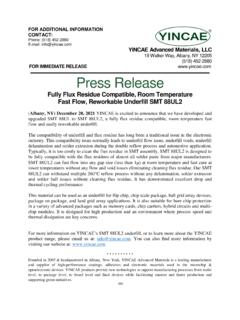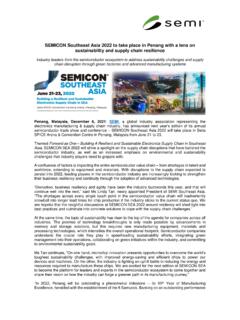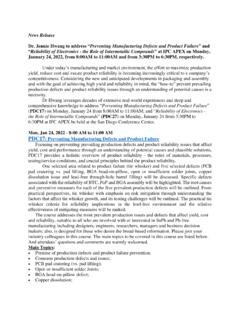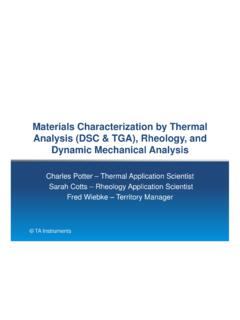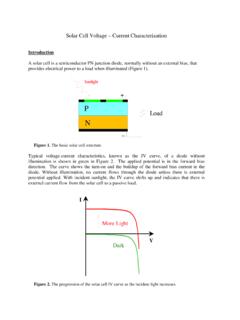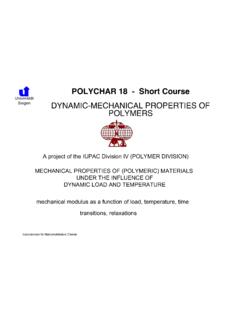Transcription of Diamond’s thermal management properties are enabling ...
1 A long-standing research collaboration between University of Bristol and Element Six is accelerating diamond s path towards unlocking highly efficient thermal management solutions for semiconductors. Collaborator: University of BristolBristol, UKElement Six s relationship with the University of Bristol can be traced back to the very origins of synthetic diamond. In the 1950s, De Beers established a secret project with the School of Physics, led by Sir Charles Frank, famous for studying dislocations in diamond and contributing to many areas of solid state physics, which sought to better understand the characteristics of natural diamond in order to artificially replicate them through the application of heat and pressure (HPHT) to graphite.
2 This work was then continued by Andrew Lang, CBE. In the late 1990s, a collaboration with Professor Mike Ashfield supported fundamental understanding of the new chemical vapour deposition (CVD) method, pioneered by Element Six, which is now unlocking new possibilities in a range of applications, from high power density electronics to water treatment and quantum forward to the 21st century, with Element Six now collaborating with Martin Kuball, Professor in Physics at the University of Bristol, in order to push new frontiers in the characterisation and application of diamond s thermal conductivity. Kuball s research, as Director of the Centre for Device Thermography and Reliability (CDTR), is focussed on the thermal management of electronics systems, including the interface of diamond with semiconductor materials such as gallium nitride (GaN) and gallium oxide (Ga2O3).
3 The collaboration has led to the development and refinement of CVD diamond thermal solutions that enable the increasingly higher power density required to meet unprecedented demand for new technologies. These include, for example, high bandwidth video calls, multimedia streaming and download services as well as data transmission from s thermal management properties are enabling higher performance semiconductor solutionsThe challengeAn increase in power density - the drive for more from smaller - has been the consistent trend across every area of electronics. Higher power densities are required for faster battery charging in electric vehicles, while higher bandwidth in base stations and satellites is needed to satisfy the need for data at low cost for video calls and streaming services.
4 To manage power densities in excess of a few kW/cm2, semiconductors need new thermal management solutions for efficient and reliable is the cause of around 50% of all failures in electronic systems, and a direct correlation exists between the junction temperature of a semiconductor device and its efficiency. For every watt of energy lost in heat, roughly 2-3 W of energy must be used for active cooling, which typically leads to increased weight, size and cost in the system. Typically, 30-40% of the energy in a high-powered radio frequency (RF) base station is lost through heat. In silicon power electronics, commonly used in planes, cars, homes and electric supply, efficiency can be as high as 94%, but any increment of improved performance over this threshold is highly next generation of wireless architecture (5G and beyond), enabled by wide bandgap semiconductors, has increased data communication speeds far beyond that of existing 4G.
5 The opportunitySynthetic diamond, with its unique properties of low density, high strength, radiation hardness, and high thermal conductivity (>2000 W/mK, more then 5x better than metals such as copper and 10x better than ceramic alternatives), offers game-changing heat spreading and dissipating CDTR at The University of Bristol specialises in thermal and thermo-mechanical simulation in electronics: identifying where and how heat loss is occurring in systems to improve thermal management . Using optical and Raman spectroscopy, researchers are able to both quantify this loss and identify where it is happening to a micrometre level.
6 Building on the University of Bristol expertise in characterising diamond, and working in partnership withElement Six, Professor Kuball s team is now able to apply this knowledge to the integration of diamond thermal management with the years, Element Six has supported the University with R&D expertise, novel materials, doctoral training and funding for PhDs and post-docs, jointly participating in EU, UK and US DARPA development programmes. In 2019, Element Six supported Professor Kuball in the launch of TherMap Solutions, a University of Bristol s spin-off company which offers quick and easy data acquisition systems for the analysis of thermal management for semiconductor materials, devices and their based characterization of diamond materials using transient thermoreflectance (TTR) Thanks to a shared journey spanning over 50 years, Element Six and the University of Bristol have spent the last two decades leveraging mutual talent and expertise to better understand some of the foundamentals of plasma chemistry, helping the design of CVD diamond recipes.
7 Today the market opening work with Kuball s team is focussed on understanding and applying the diamond developed through those recipes to deliver improved efficiency in the semiconductor industry. Dr Daniel Twitchen, Chief Technologist, Element SixThe solutionThanks to this collaboration with The University of Bristol, over the last 10 years Element Six has perfected its CVD diamond to deliver wafers that can be cut and processed to provide robust, low weight heat spreaders, achieving lower operating temperatures and improved performance. With precision analysis of heat loss, junction temperatures can be reduced by up to 40 C, with device efficiencies increasing by 10% or more.
8 Diamond s incredible properties really come into play in extremely high-powered electronics. An understanding of how to make the interface between the diamond heat spreader and the semiconductor material as effective as possible at high power densities has been crucial to unlocking this is where Professor Kuball s background as an applied physicist, including his innovative work at Brown University on GaN laser diodes, has proven so beneficial. When Element Six first pioneered the use of diamond for cooling GaN devices, Professor Kuball s analysis enabled the identification of flaws within the thermal boundary between device wafer and diamond, allowing the company to significantly improve its original process.
9 At high power, thermal conductivity challenges increase significantly. What might work as a material solution in a lower powered device, such as a regular GaN laser diode, will not prove as effective in an RF device operating at extremely high voltage or, in the case of satellites, in extreme temperature cycles. This performance also needs to be sustained over time. Professor Martin Kuball, University of BristolNext stepsIn future, diamond s opportunity and challenge , says Professor Kuball, will be in its integration with other materials, such as silicon carbide (SiC), GaN, and even gallium oxide. Professor Kuball is one of just eight UK academics to receive support from the Royal Academy of Engineering as part of a 22 million research funding scheme - the Chairs in Emerging Technologies.
10 For his project, Ultrawide bandgap emerging power electronics for a low carbon economy , Kuball aims to develop a new class of semiconductor power electronic devices using ultra-wide bandgap materials, such as gallium oxide, boron nitride (BN) and aluminium nitride (AIN). These new devices will be compact, highly versatile and, crucially, more energy efficient. Materials such as gallium oxide offer the possibility of a highly effective superjunction when combined with diamond enabling very high voltage electronics, but working with them presents many new challenges. With continued knowledge sharing and support from Element Six, these challenges are likely to be overcome through ongoing advances in the characterisation and optimisation of the interface between novel materials and diamond thermal management solutions.

